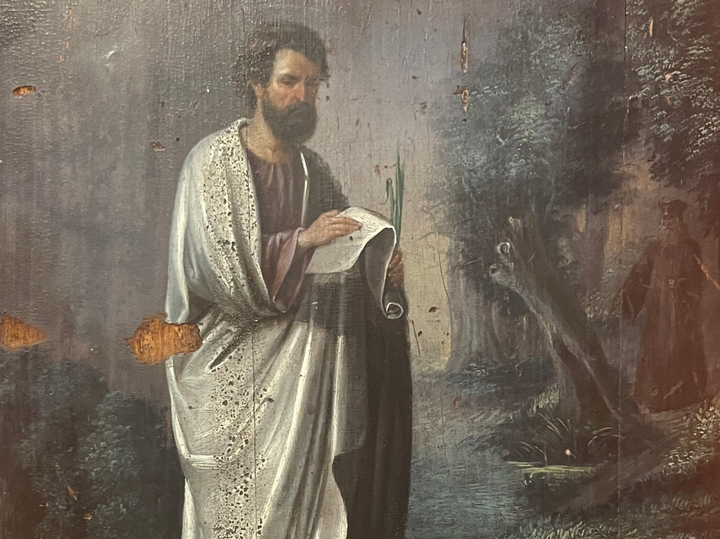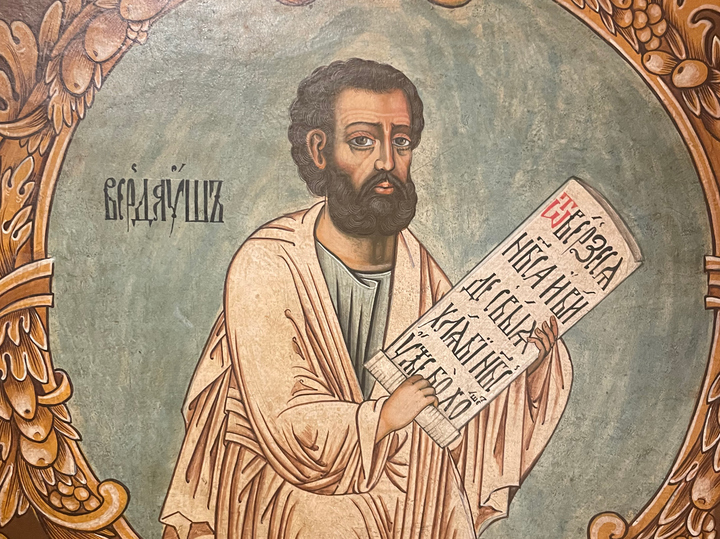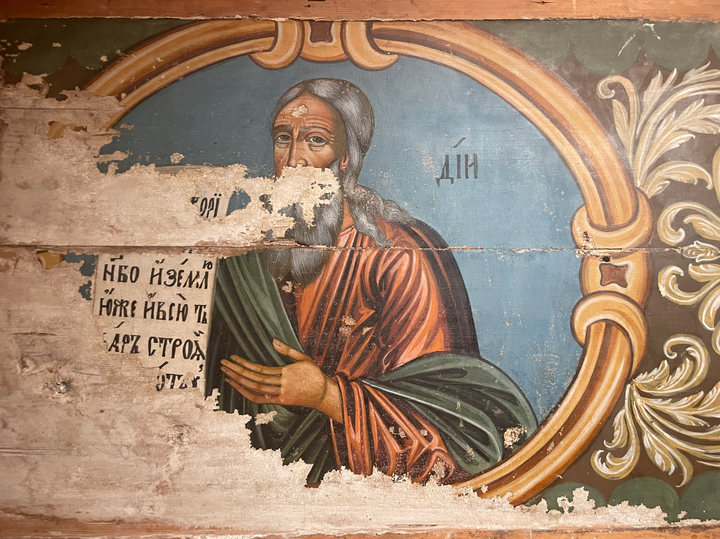Zeus and Virgil found on Orthodox icons
[ad_1]
How the heroes of antiquity got into the temples
The Andrey Rublev Museum presented a small but significant exhibition “Greek Wise Men”, which demonstrates unique monuments of Russian church culture. Before us are icon-painting images of pagans: the Roman poet Virgil, the ancient Greek god Zeus and the Athenian ruler Solon, who, from the beginning of the 18th century, adorned the iconostasis of the wooden church of a small village in the Tver region. How ancient philosophers and poets ended up in a temple in the Russian hinterland, MK learned.
In total, four icon-painting monuments are presented in the chamber space of the small exhibition hall of the Church of the Archangel Michael, three of them are shown for the first time. One of them was created in the second half of the 19th century. This is not a classical icon, more like a painting in the style of classical academicism. It depicts the Roman philosopher Justin, who lived in the second century AD. He converted to Christianity, became a missionary and suffered for his faith: he was executed in 165. Icons depicting the philosopher-martyr are found in Orthodox and Catholic churches, but here the audience is presented with a rare example of an almost secular image of Justin. A martyr in classical robes for a Roman philosopher, without a halo above his head, holds a scroll in his hands. To the side, in the shade of the trees, is another figure. Obviously, this is Justin’s opponent, the Cynic philosopher Crescentus, with whom they argued publicly. Perhaps Crescent was involved in the execution of Justin. This pictorial icon was added to the museum’s collection last year (it was bought from a private individual).

Three more monuments belong to the same ensemble of the beginning of the 18th century. Once they decorated the church of Seltsa-Karelsky, Udomelsky district, Tver region. In the 1970s, an expedition of the Andrei Rublev Museum worked there and found two of the icons on display. And quite recently, in one of the private collections, a third one was found – from the same series. It was attributed by the famous researcher Alexander Preobrazhensky. For the first time, the public can see them together.
“These images were painted, presumably, by Novgorod masters in Seltse-Karelsky during the time of Peter the Great, in 1719-1721,” Alexei Gulmanov, curator of the exhibition, deputy head of the research department of the Rublev Museum, tells MK. — They were located in the local row of the iconostasis, that is, under the icons of the local row, at the level of the parishioners’ feet. These are not holy characters – the Hellenic sages: pagans who predicted the birth of Christ.

“Prophecies of the Hellenic Wise Men” – a collection of texts with the sayings of ancient philosophers and poets – appeared in Rus’ in the 16th century and was rewritten more than once. The “pagan apology” of Christianity, apparently, served as the main source of images that began to appear in Russian churches in the 16th century. They can be found in the Annunciation Cathedral of the Moscow Kremlin, in the Church of the Life-Giving Trinity in Ostankino, they met in the churches of Novgorod and Pskov. But rarely. And usually on the doors, somewhere at the entrance to the temple. In Russia, there are no more than a dozen churches where you can find images of the Hellenic sages. And for them to show up in a village far from big cities is a very unique case. So how did Zeus and Virgil get to Seltso-Karelskoye?
– This village was assigned to one of the Novgorod monasteries – Malo-Kirillov, – explains Gulmanov. – Apparently, the abbot of the monastery supervised the design of the temple and brought craftsmen from Novgorod. The images are written by different hands, but in the same style. All the sages are depicted without halos, but their images are similar to the usual images of Orthodox saints. For example, in Greek Orthodox churches one can also meet the ancient sages, but they are depicted in a bizarre way – in strange caps, non-standard clothes. There is no such thing here. Everyone has a scroll with a prophecy about the coming of Christ in their hands. The words of Dius – as Zeus was called in the Slavic language – are partially taken from the sermon of the Apostle Paul, who, together with Barnabas, preached in the city of Lystra, and there they were mistaken for the gods – Zeus and Hermes. And partly – from the book of Makaveev. But Virgil is quoted almost verbatim. True, he is called Verdyaush here – in the Polish manner. Latin books most often came to Rus’ through Poland. Here are the words of one of his works – the fourth Eclogue, which since early Christian times was considered a prophecy of the birth of Christ. Moreover, Virgil referred to the prophecy of the soothsayer Sibyl.

Before us are rare monuments. Today, such people can be counted on the fingers of one hand. Many images of ancient heroes were destroyed as inappropriate to the canon. These unique images have survived to this day, obviously, precisely because they were located in a distant small village. They testify to how ornately intertwined cultures of different peoples and eras.
[ad_2]
Source link






